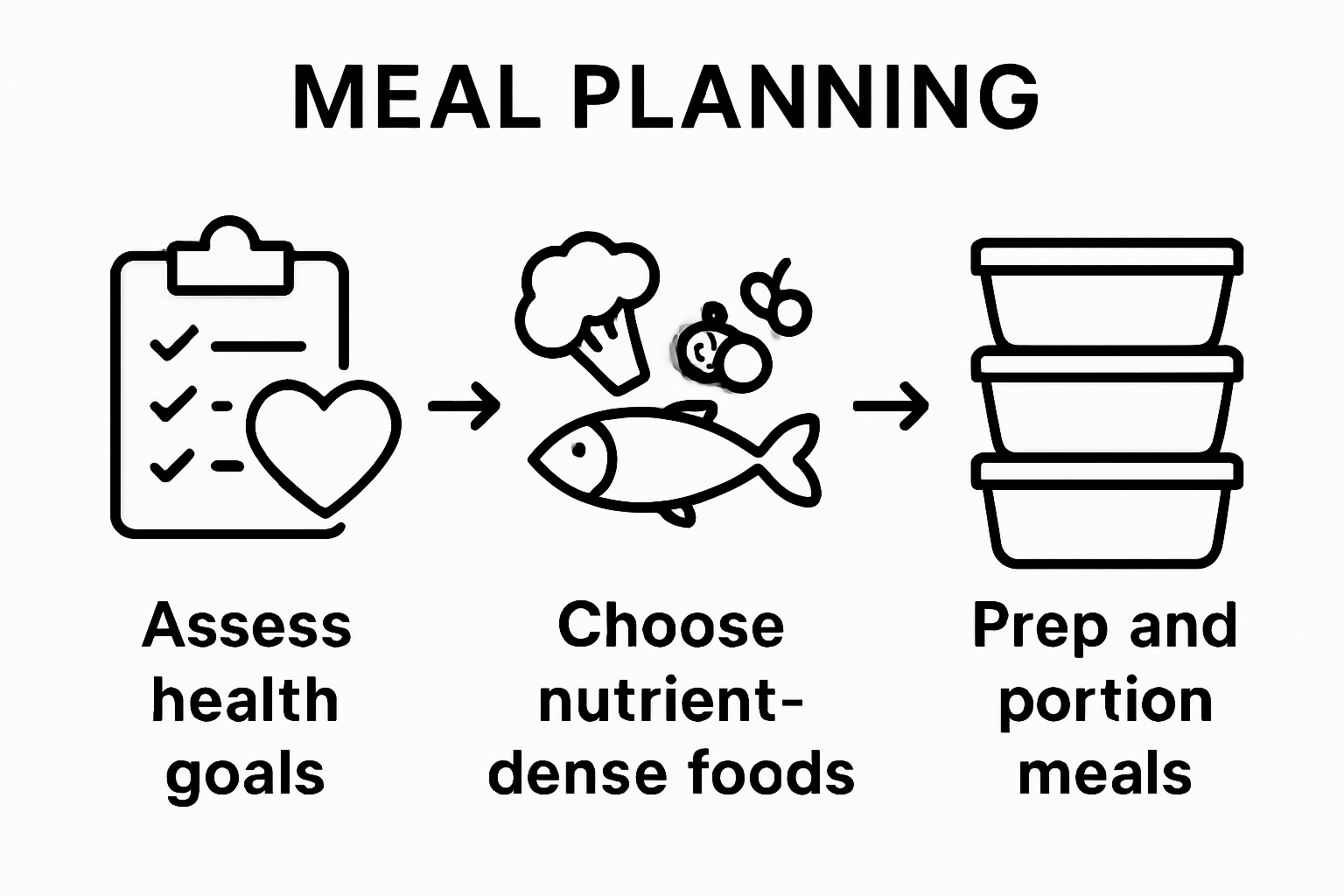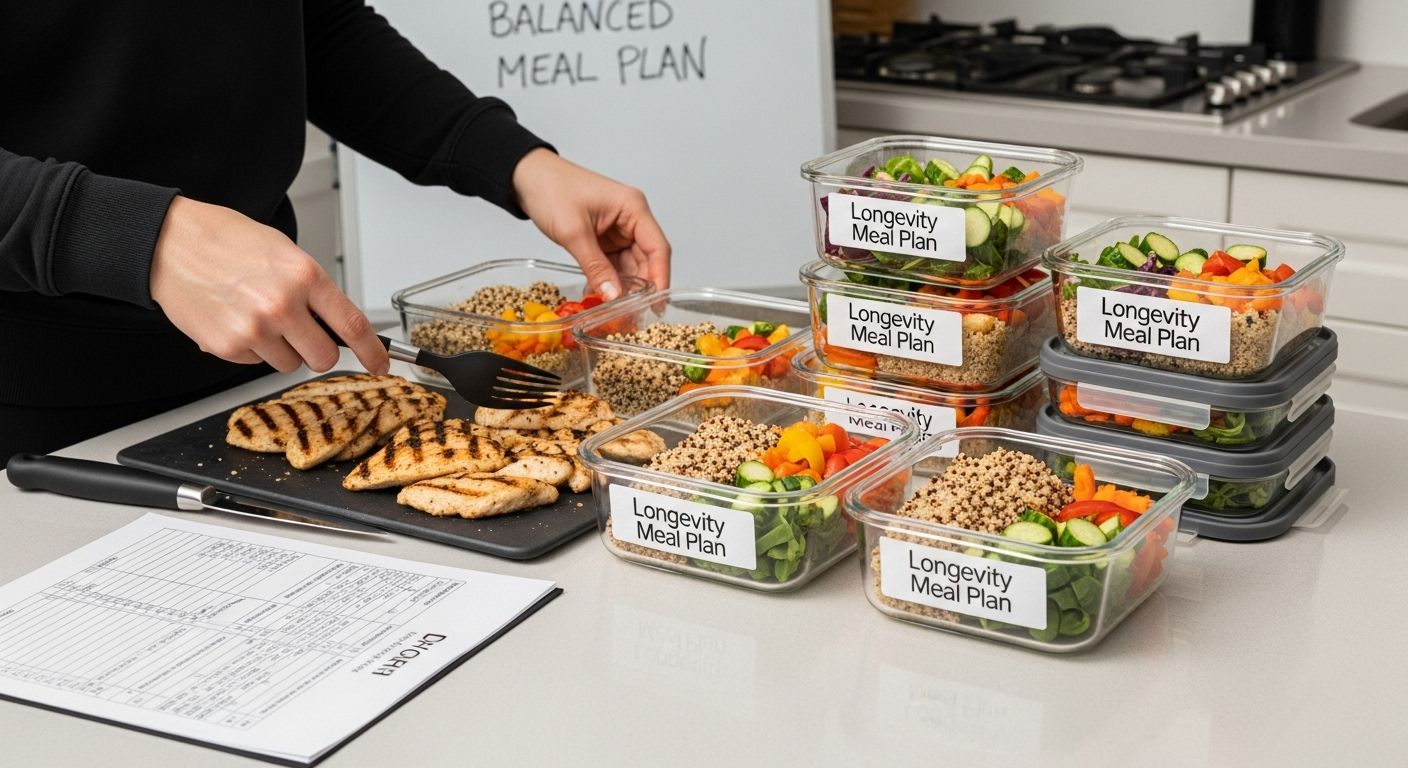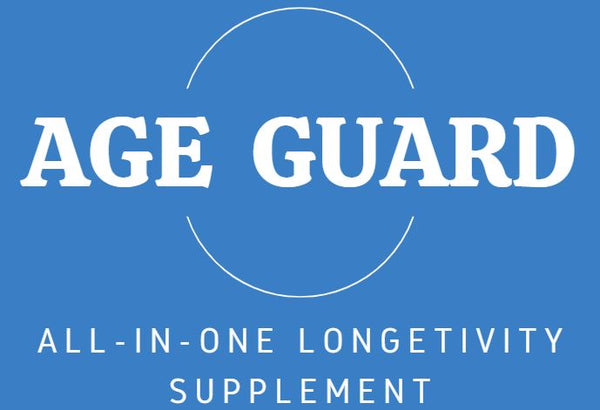
Meal Planning Guide for Longevity
Share

Eating for longevity sounds straightforward and yet over 90 percent of Americans miss key nutrients essential for long-term health. Most people pour energy into new diets or trendy meal plans and still end up confused about what actually works. The real secret is not grabbing random superfoods or following strict rules but building a meal plan that fits your life, your goals, and even your genes.
Table of Contents
- Step 1: Assess Your Dietary Needs And Goals
- Step 2: Research Nutrient-Dense Foods For Longevity
- Step 3: Create A Balanced Meal Plan Template
- Step 4: Shop For Ingredients Based On Your Plan
- Step 5: Prepare And Store Meals Efficiently
- Step 6: Monitor And Adjust Your Meal Plan Regularly
Quick Summary
| Key Point | Explanation |
|---|---|
| 1. Assess your dietary needs first | Conduct a personal health assessment to create a tailored nutrition roadmap based on your unique goals and health status. |
| 2. Focus on nutrient-dense foods | Identify and prioritize foods high in vitamins and minerals that support health and combat chronic diseases. |
| 3. Develop a flexible meal plan template | Create a dynamic meal plan that balances macronutrients and allows for variety to maintain interest and adherence. |
| 4. Shop purposefully for ingredients | Use a detailed grocery list aligned with your meal plan to ensure nutrition goals are met while minimizing impulse purchases. |
| 5. Regularly monitor and adjust your plan | Track your nutritional intake and health metrics to adapt your meal plan based on changing needs and progress. |
Step 1: Assess Your Dietary Needs and Goals
Longevity meal planning begins with a comprehensive understanding of your unique nutritional requirements and health objectives. This critical first step transforms generic dietary advice into a personalized roadmap designed specifically for your body and wellness goals.
Personal Health Assessment
Starting your longevity meal planning journey requires honest self-evaluation. Examine your current health status, including age, weight, existing medical conditions, energy levels, and specific health objectives. Are you aiming to prevent chronic diseases, manage weight, improve cardiovascular health, or boost overall vitality? Each goal demands a nuanced nutritional approach.
According to research from the French National Institute of Health and Medical Research, individuals who conduct thorough personal health assessments are more likely to develop sustainable dietary strategies. Your assessment should consider several key factors:
- Current medical history and potential genetic predispositions
- Metabolic rate and body composition
- Stress levels and sleep quality
- Physical activity and fitness goals
- Existing dietary habits and potential nutritional deficiencies
Creating Your Nutritional Profile
Transform your health assessment into a detailed nutritional profile. This isn’t about restrictive dieting but developing a balanced, personalized eating strategy that supports long-term wellness. Consult healthcare professionals like registered dietitians or nutritionists who can provide targeted guidance. They can help you develop a comprehensive understanding of your body’s specific nutrient requirements.
A professional assessment typically involves comprehensive blood work, metabolic testing, and detailed discussions about your lifestyle. These insights help create a meal planning approach that addresses your unique physiological needs while supporting your longevity objectives. The goal is creating a sustainable nutrition strategy that feels natural and enjoyable, not like a restrictive regimen.
By meticulously assessing your dietary needs and goals, you establish a solid foundation for your longevity meal planning guide. This initial step ensures that subsequent meal strategies are precisely tailored to your individual health requirements, setting the stage for a transformative nutritional journey.
Below is a summary table outlining the main steps of longevity meal planning, including the purpose and key outcome for each stage.
| Step | Purpose | Key Outcome |
|---|---|---|
| Assess Dietary Needs | Identify unique nutritional requirements and health goals | Personalized nutrition roadmap |
| Research Nutrient-Dense Foods | Find foods rich in essential vitamins and minerals | Nutrient-based food list |
| Create Meal Plan Template | Develop a balanced and flexible strategy | Structured meal planning framework |
| Shop for Ingredients | Purchase foods aligned with plan | Stocked kitchen with suitable ingredients |
| Prepare and Store Meals | Efficiently prepare and preserve meals | Convenient, healthy options ready to eat |
| Monitor and Adjust Plan | Track progress and refine strategies | Ongoing improvement and personalization |
Step 2: Research Nutrient-Dense Foods for Longevity
Understanding the power of nutrient-dense foods is fundamental to developing a successful longevity meal planning strategy. This step transforms your dietary approach from basic sustenance to a targeted wellness intervention designed to support long-term health and vitality.
Identifying Nutritional Powerhouses
Nutrient-dense foods are the foundation of a longevity-focused diet. These are ingredients packed with essential vitamins, minerals, antioxidants, and beneficial compounds that actively support cellular health and combat age-related deterioration. Think of these foods as your body’s natural defense mechanism against chronic diseases and metabolic decline.
According to research from the American Heart Association, prioritizing whole, minimally processed foods is crucial for long-term health. Your research should focus on foods that deliver maximum nutritional value with minimal caloric intake. Key categories include:
- Dark leafy greens (spinach, kale, Swiss chard)
- Colorful berries rich in antioxidants
- Fatty fish high in omega-3 fatty acids
- Nuts and seeds with complex nutritional profiles
- Lean proteins from plant and sustainable animal sources
Strategic Nutritional Exploration
Researching nutrient-dense foods requires a systematic approach. Start by consulting reputable nutrition databases, scientific publications, and expert-reviewed resources. Learn about the specific health benefits of each food, understanding how their unique nutritional profiles contribute to cellular repair, inflammation reduction, and metabolic optimization.
Consider exploring traditional dietary patterns known for promoting longevity, such as the Mediterranean and Okinawan diets. These time-tested nutritional strategies offer valuable insights into balanced, health-promoting eating habits.
By meticulously researching nutrient-dense foods, you create a robust nutritional blueprint that goes beyond simple meal planning. This step empowers you to make informed dietary choices that actively support your longevity goals, transforming eating from a routine activity into a strategic health intervention.
Step 3: Create a Balanced Meal Plan Template
Developing a balanced meal plan template transforms your nutritional research into a practical, actionable strategy for longevity. This critical step bridges the gap between understanding nutrient-dense foods and actually implementing them in your daily life.
Structural Nutrition Framework
A well-constructed meal plan template serves as your nutritional roadmap, providing structure while maintaining flexibility. Begin by dividing your daily nutrition into strategic components that ensure comprehensive nutrient coverage. Precision is key - your template should account for macronutrient balance, micronutrient diversity, and portion control.
According to research from Harvard’s School of Public Health, an ideal meal template follows a visual proportion guide:
- 50% of plate dedicated to fruits and vegetables
- 25% allocated to whole grains
- 25% reserved for lean proteins
- Small allowance for healthy fats
Utilize digital tools or a physical notebook to create your template. Spreadsheet applications like Google Sheets or specialized meal planning apps can streamline this process, allowing you to track nutritional content, rotate meal varieties, and maintain consistent dietary goals. Consider creating separate templates for weekdays and weekends, recognizing that lifestyle variations might require different nutritional approaches.
Personalization and Adaptability
Your meal plan template must be dynamic, not rigid. Explore our comprehensive guide on longevity science to understand the importance of personalized nutrition. Account for individual factors like metabolic rate, activity levels, and specific health objectives. Build in flexibility that allows occasional modifications without derailing your entire nutritional strategy.
Design your template with strategic variety to prevent dietary monotony. Rotate protein sources, experiment with different vegetable preparations, and incorporate seasonal produce. This approach ensures nutritional diversity while keeping meals interesting and sustainable. Include spaces for tracking how different foods make you feel, creating a feedback mechanism that allows continuous refinement of your longevity meal planning approach.

By meticulously crafting a balanced meal plan template, you establish a robust foundation for consistent, health-optimizing nutrition that supports your long-term wellness objectives.
Step 4: Shop for Ingredients Based on Your Plan
Ingredient shopping represents the critical bridge between your nutritional strategy and actual implementation. This step transforms your carefully crafted meal plan from theoretical concept to tangible reality, demanding strategic approach and mindful selection.
Strategic Shopping Preparation
Prepare for your shopping expedition by treating your meal plan template as a precise roadmap. Digital tools are invaluable for this process. Create a comprehensive grocery list directly linked to your meal plan, organizing items by nutritional categories and store sections. This methodical approach minimizes impulse purchases and ensures you acquire precisely what your longevity nutrition strategy requires.
According to research from the National Center for Biotechnology Information, strategic meal planning is associated with better nutritional adherence and reduced likelihood of weight-related health challenges. Your shopping strategy should prioritize whole, minimally processed ingredients that align with your nutrient-dense food research.
- Fresh produce sections for vibrant vegetables and fruits
- Lean protein sources from sustainable origins
- Whole grain selections
- Healthy fat options like nuts, seeds, and quality oils
- Minimal processed food selections
Navigating the Shopping Environment
Approach grocery shopping with deliberate intention. Shop the perimeter of the store, where fresh ingredients typically reside. This strategy naturally steers you toward whole foods while minimizing exposure to processed alternatives. Explore our comprehensive guide on longevity science to understand the deeper nutritional principles guiding your selections.
Develop a disciplined shopping mindset. Read nutrition labels carefully, understand ingredient lists, and remain committed to your nutritional goals. Consider shopping frequency that supports ingredient freshness - perhaps smaller, more frequent trips that ensure peak nutritional quality. Some health-conscious shoppers prefer weekly farmers market visits or community-supported agriculture programs to access the most nutrient-rich ingredients.
By executing a purposeful, well-planned shopping strategy, you transform your longevity meal planning from theoretical concept to practical, actionable nutrition that supports your long-term wellness objectives.
Step 5: Prepare and Store Meals Efficiently
Meal preparation and storage represent the critical translation of your nutritional strategy into practical, everyday sustenance. This step transforms your carefully selected ingredients into organized, readily accessible meals that support your longevity goals while maximizing time and nutritional integrity.
Advanced Preparation Techniques
Strategic meal preparation is the cornerstone of maintaining consistent nutrition. Dedicate specific blocks of time weekly for comprehensive meal preparation, typically 2-3 hours where you can chop vegetables, cook proteins, and assemble foundational meal components. Invest in high-quality storage containers that preserve food quality and make portioning straightforward. Glass containers with tight-sealing lids work excellently for maintaining ingredient freshness and preventing contamination.
According to research from the Harvard T.H. Chan School of Public Health, effective meal preparation involves planning ahead and organizing ingredients systematically. Consider preparing versatile base ingredients that can be mixed and matched across multiple meals, providing flexibility while reducing overall cooking time.
- Roast multiple protein sources simultaneously
- Chop vegetables for quick stir-fries and salads
- Cook whole grains in batch quantities
- Prepare sauce and seasoning mixes in advance
Intelligent Storage and Preservation
Proper storage is fundamental to maintaining meal quality and preventing nutritional degradation. Temperature and container selection matter significantly. Utilize refrigeration and freezing techniques that preserve nutritional value while preventing bacterial growth. Learn more about optimal nutrition strategies to deepen your understanding of food preservation.
Implement a systematic labeling approach for your prepared meals. Include preparation date, contents, and recommended consumption timeline. Most prepared meals maintain optimal quality for 3-5 days when refrigerated, with some protein and grain combinations lasting up to a week. Freezing provides extended preservation, allowing you to prepare larger quantities and store portions for future consumption.
By mastering efficient meal preparation and storage, you create a sustainable nutritional system that supports your longevity goals while providing convenience and consistent healthy eating.
This table helps organize key strategies for efficient meal preparation and storage, clarifying timing, techniques, and expected shelf life to support meal plan consistency.
| Preparation Task | Technique | Suggested Timing | Storage Method | Typical Shelf Life |
|---|---|---|---|---|
| Batch-cooking Proteins | Roast, bake, or grill multiple types at once | Weekly (2-3 hours) | Refrigerate or freeze | 3-5 days (fridge), up to 3 months (freezer) |
| Pre-chopping Vegetables | Cut and portion for easy assembly | Weekly or biweekly | Store in airtight containers | 3-5 days |
| Cooking Grains in Bulk | Prepare whole grains for use in multiple meals | Weekly | Refrigerated or frozen | 5-7 days (fridge), 1 month (freezer) |
| Preparing Sauces/Seasonings | Mix dressings, marinades, or blends | Weekly | Small sealed containers | 5-7 days |
| Labeling and Organizing Meals | Date and list contents on containers | Ongoing | N/A | Ensures safe consumption |
| Using Quality Containers | Opt for glass or BPA-free plastics | As needed | Airtight storage | Maintains freshness |

Step 6: Monitor and Adjust Your Meal Plan Regularly
Nutrition is a dynamic journey, not a static destination. Monitoring and adjusting your meal plan represents the critical final stage of your longevity nutrition strategy, ensuring continuous alignment with your evolving health objectives and physiological needs.
Performance Tracking Systems
Systematic documentation forms the backbone of effective meal plan monitoring. Create a comprehensive tracking system that captures multiple dimensions of your nutritional experience. Utilize digital tools like smartphone apps or spreadsheets to record key metrics such as energy levels, sleep quality, physical performance, mood variations, and specific health markers. Consistency is crucial in gathering meaningful data that reveals long-term nutritional impact.
According to research published in BMC Public Health, individuals who actively monitor their dietary patterns demonstrate superior nutritional adherence and health outcomes. Your tracking should include both objective measurements and subjective experiences, providing a holistic view of your nutritional strategy’s effectiveness.
- Weekly body weight measurements
- Monthly body composition assessments
- Energy level and mood tracking
- Detailed food consumption logs
- Physical performance metrics
Adaptive Nutritional Strategy
View your meal plan as a living document requiring periodic refinement. Explore our comprehensive guide on longevity science to understand the intricate relationship between nutrition and biological adaptation. Schedule quarterly comprehensive reviews where you critically assess your tracking data, consulting healthcare professionals or nutritionists for expert insights.
Remember that your body’s nutritional requirements transform with age, stress levels, physical activity, and overall health status. Be prepared to make incremental adjustments rather than implementing radical changes. Look for patterns in your tracking data that suggest potential nutritional gaps or emerging health trends. Some modifications might involve subtle macronutrient ratio adjustments, introducing new nutrient-dense foods, or addressing specific micronutrient requirements.
By establishing a robust monitoring and adjustment framework, you transform your longevity meal plan from a static blueprint into a responsive, personalized nutrition system that evolves alongside your health journey.
Transform Your Meal Planning Into Lasting Health Success
Are you struggling to turn your personalized longevity meal plan into real, everyday results? You understand the importance of nutrient-dense foods and want to optimize each meal for long-term wellness. Yet, staying consistent takes more than just good intentions—it demands the right support and simple, science-backed solutions.
Explore our curated range of longevity health supplements, perfectly designed to complement your daily nutrition. Visit our Home page – Age Guard to discover targeted options that help fill common nutritional gaps discussed in your meal planning journey.

Ready to experience higher energy, better vitality, and greater confidence in your food choices? Enhance your meal planning strategy right now by visiting https://myageguard.com. Choose a supplement that fits your unique goals so you can take the next step toward healthy living for years to come.
Frequently Asked Questions
What are nutrient-dense foods, and why are they important for longevity?
Nutrient-dense foods are those packed with essential vitamins, minerals, and beneficial compounds while being lower in calories. They support long-term health by promoting cellular repair, reducing inflammation, and combating age-related deterioration.
How can I create a balanced meal plan based on my dietary needs?
Start by assessing your personal health requirements and goals, then research nutrient-dense foods. Create a meal plan template that divides your daily meals into the right proportions of fruits, vegetables, whole grains, and lean proteins to ensure comprehensive nutrient coverage.
What is the importance of monitoring my meal plan regularly?
Regular monitoring of your meal plan allows you to track your nutritional intake and its impact on your health. It helps identify patterns in energy levels, mood, and overall wellness, enabling you to make informed adjustments that align with your evolving health objectives.
What are some effective meal preparation techniques for busy individuals?
Dedicate 2-3 hours weekly for meal prep, utilizing advanced techniques such as batch cooking proteins, chopping vegetables in advance, and preparing versatile base ingredients. Use high-quality storage containers to maintain freshness and keep meals organized for easy access.
